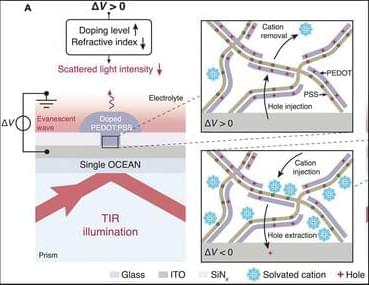Monitoring electrical potentials with high recording site density and micrometer spatial resolution in liquid is critical in biosensing. Organic electronic materials have driven remarkable advances in the field because of their unique material properties, yet limitations in spatial resolution and recording density remain. Here, we introduce organic electro-scattering antennas (OCEANs) for wireless, light-based probing of electrical signals with micrometer spatial resolution, potentially from thousands of sites. The technology relies on the unique dependence of poly(3,4-ethylenedioxythiophene):polystyrene sulfonate light scattering properties to its doping level. Electro-optic characteristics of individual antennas varying in diameters and operating voltages were systematically characterized in saline solution. Signal-to-noise ratios up to 48 were achieved in response to 100-mV stimuli, with 2.5-mV detection limits. OCEANs demonstrated millisecond time constants and exceptional long-term stability, enabling continuous recordings over 10 hours. By offering spatial resolution of 5 μm and a recording density of 4 × 106 cm−2, OCEANs unlock new readout capabilities, potentially accelerating fundamental and clinical research.
Sci. Adv. 10, eadr8380 (2024). DOI:10.1126/sciadv.adr8380
Select the format you want to export the citation of this publication.
